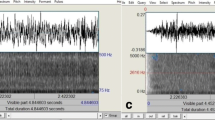Abstract
Purpose
The aim of this study is to describe a distinctive respiratory pattern seen in subjects with inferior turbinate hypertrophy, nasal obstruction, and a polysomnogram-proven diagnosis of primary snoring or mild obstructive sleep apnea. These subjects demonstrated increased snoring with purely nasal breathing and alleviation of snoring with oral breathing. The study design is case series with chart review. The setting was a university-based tertiary care hospital.
Methods
A retrospective chart review was performed for patients with complaints of nasal obstruction with associated inferior turbinate hypertrophy and a polysomnogram-proven diagnosis of mild obstructive sleep apnea or primary snoring. Demographic and polysomnography information were collected and analyzed. Snoring and airflow patterns were reviewed.
Results
Twenty-five subjects were identified as having met the inclusion and exclusion criteria on polysomnography for either primary snoring or mild obstructive sleep apnea with inferior turbinate hypertrophy and no other significant nasal deformity or abnormality. Seventeen (68 %) of these patients had polysomnograms which demonstrated snoring during nasal breathing and alleviation of snoring with oral breathing. Of the 17 who snored during nasal breathing, ten of the subjects were female and seven of the subjects were male. The mean age was 27 years (range 18 to 68 years). The mean apnea–hypopnea index was 2.3 events/h (range 0 to 9.7 events/h). The mean body mass index was 25 kg/m2 (range 20 to 43 kg/m2).
Conclusion
Our study describes a newly recognized pattern of snoring in patients with a polysomnogram-proven diagnosis of either primary snoring or mild obstructive sleep apnea. This pattern of breathing demonstrates patients who snore during nasal breathing even with known nasal obstruction present and subsequently have resolution or improvement of the snoring with oral breathing.




Similar content being viewed by others
References
Jennum P, Sjol A (1993) Snoring, sleep apnoea and cardiovascular risk factors: the MONICA II Study. Int J Epidemiol 22(3):439–444
Young T, Finn L, Kim H (1997) Nasal obstruction as a risk factor for sleep-disordered breathing. The University of Wisconsin Sleep and Respiratory Research Group. J Allergy Clin Immunol 99(2):S757–762
Horner RL (2008) Pathophysiology of obstructive sleep apnea. J Cardiopulm Rehabil Prev 28(5):289–298
Rundcrantz H (1969) Postural variations of nasal patency. Acta Otolaryngol 68(5):435–443
Heetderks D (1927) Observations on the reaction of normal nasal mucous membrane. Am J Med Sci 174:231–243
Morris LG, Burschtin O, Setlur J, Bommelje CC, Lee KC, Jacobs JB, Lebowitz R (2008) REM-associated nasal obstruction: a study with acoustic rhinometry during sleep. Otolaryngol Head Neck Surg 139(5):619–623
Smith PL, Wise RA, Gold AR, Schwartz AR, Permutt S (1988) Upper airway pressure–flow relationships in obstructive sleep apnea. J Appl Physiol (Bethesda, MD) 64(2):789–795
Meurice JC, Marc I, Carrier G, Series F (1996) Effects of mouth opening on upper airway collapsibility in normal sleeping subjects. Am J Respir Crit Care Med 153(1):255–259
Georgalas C (2011) The role of the nose in snoring and obstructive sleep apnoea: an update. Eur Arch Oto-Rhino-L 268(9):1365–1373
Lee SA, Amis TC, Byth K, Larcos G, Kairaitis K, Robinson T, Wheatley JR (2008) Heavy snoring as a cause of carotid artery atherosclerosis. Sleep 31(9):1207–1213
Hedner JA, Wilcox I, Sullivan C (1994) Speculations on the interaction between vascular disease and obstructive sleep apnoea. In: Saunders N, Sullivan C (eds) Sleep and breathing, 2nd edn. Marcel Dekker, New York, pp 823–846
Tsuda H, Lowe AA, Chen H, Fleetham JA, Ayas NT, Almeida FR (2011) The relationship between mouth opening and sleep stage-related sleep disordered breathing. J Clin Sleep Med JCSM Off Publ Am Acad Sleep Med 7(2):181–186
Vroegop AV, Vanderveken OM, Van de Heyning PH, Braem MJ (2012) Effects of vertical opening on pharyngeal dimensions in patients with obstructive sleep apnoea. Sleep Med 13(3):314–316
Susarla SM, Thomas RJ, Abramson ZR, Kaban LB (2010) Biomechanics of the upper airway: changing concepts in the pathogenesis of obstructive sleep apnea. Int J Oral Maxillofac Surg 39(12):1149–1159
Douglas NJ, White DP, Weil JV, Zwillich CW (1983) Effect of breathing route on ventilation and ventilatory drive. Respir Physiol 51(2):209–218
White DP, Cadieux RJ, Lombard RM, Bixler EO, Kales A, Zwillich CW (1985) The effects of nasal anesthesia on breathing during sleep. Am Rev Respir Dis 132(5):972–975
Kohler M, Bloch KE, Stradling JR (2007) The role of the nose in the pathogenesis of obstructive sleep apnoea and snoring. Eur Respir J Off J Eur Soc Clin Respir Physiol 30(6):1208–1215
Rappai M, Collop N, Kemp S, deShazo R (2003) The nose and sleep-disordered breathing: what we know and what we do not know. Chest 124(6):2309–2323
Conflict of interest
None of the authors has any conflict of interest.
Author information
Authors and Affiliations
Corresponding author
Additional information
The work was completed in the Department of Otolaryngology at Stanford University Medical Center.
Rights and permissions
About this article
Cite this article
Hsia, J.C., Camacho, M. & Capasso, R. Snoring exclusively during nasal breathing: a newly described respiratory pattern during sleep. Sleep Breath 18, 159–164 (2014). https://doi.org/10.1007/s11325-013-0864-x
Received:
Revised:
Accepted:
Published:
Issue Date:
DOI: https://doi.org/10.1007/s11325-013-0864-x




